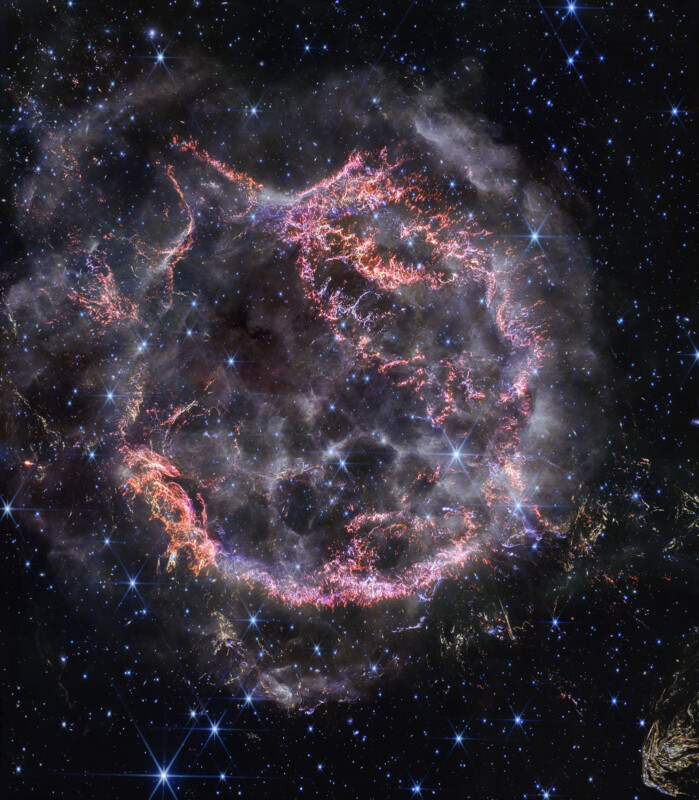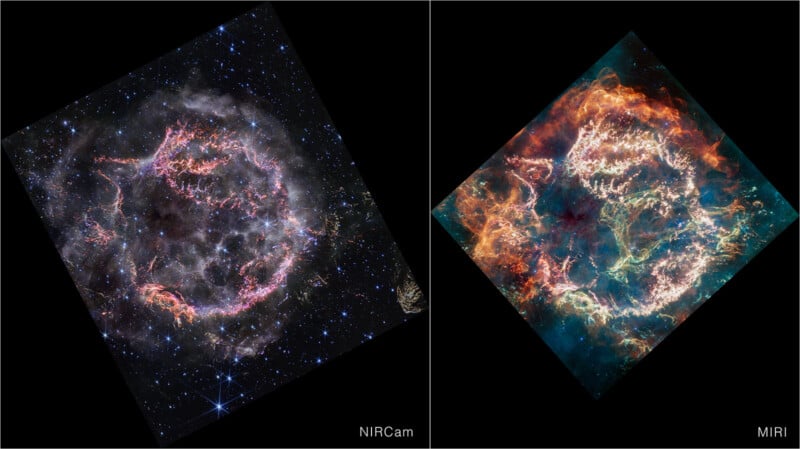Supernova Remnant Cas A Shines and Confounds in Webb’s Newest Portrait

In April, the James Webb Space Telescope kick-started a new era of investigation into Cassiopeia A (Cas A), a prototypical supernova remnant that has been the subject of extensive study by numerous telescopes. Today, researchers shared another view of Cas A that has stunned astronomers.
Using its Near-Infrared Camera (NIRCam), Webb’s new view of Cas A shows the remains of the famous violent supernova explosion in unprecedented detail and resolution, revealing intricate details and introducing an exciting new mystery.
One thing immediately noticeable is that the image of Cas A that Webb captured earlier this year using its Mid-Infrared Instrument (MIRI) appeared much more colorful than the new NIRCam image, especially when looking at the supernova remnant’s inner shell.

“At first glance, the NIRCam image may appear less colorful than the MIRI image. However, this does not mean there is less information: it simply comes down to the wavelengths in which the material in the object is emitting its light,” explains a press release on the European Space Agency’s website, also shared by NASA and STScI.
NIRCam’s rendition of Cas A is “devoid of color” because the dust seen in the mid-infrared wavelengths is not being heated enough by the remains of the supernova blast to appear in the near-infrared wavelengths seen by NIRCam.
As image processors Joseph DePasquale and Alyssa Pagan of STScI explained to PetaPixel earlier this year, the colors seen in Webb’s images are the result of scientists assigning color channels to individual wavelength filters. Webb, like other space telescopes, captures monochromatic photos. Processors introduce carefully selected colors when creating Webb’s final images using chromatic ordering and replicating how people see visible light wavelengths.
“Researchers say the white color is light from synchrotron radiation, which is emitted across the electromagnetic spectrum, including the near-infrared. It’s generated by charged particles traveling at extremely high speeds spiraling around magnetic field lines. Synchrotron radiation is also visible in the bubble-like shells in the lower half of the inner cavity,” reads the release.
Alongside the absence of specific colors, the loop of green light seen in MIRI’s portrait of Cas A also doesn’t appear in NIRCam’s image. Nicknamed the “Green Monster” by scientists, the NIRCam shot sees something entirely different, faintly outlined circular holes that show ionized gas.

While NIRCam may not have captured Cas A’s now-iconic Green Monster, the near-infrared wavelengths picked up something fascinating. In the bottom right corner of NIRCam’s field of view, a “large striated blob” appears to be an “offspring of the main supernova.”
Dubbed “Baby Cas A,” the bright blob is a light echo, “where light from the star’s long-ago explosion has reached and is warming distant dust, which is glowing as it cools down.” The object’s intricate dust pattern and relative closeness to Cas A are “intriguing.” Baby Cas A is not quite as close as it appears; it’s about 170 light-years behind the large supernova remnant.
Something else related to size and proximity in Cassiopeia A is especially notable in Webb’s NIRCam portrait. While the instrument offers the highest resolution of any space telescope, even Webb cannot fully resolve all of Cas A’s debris. If a filament of debris doesn’t appear, it must be similar to or smaller than 16 billion kilometers across, or around 100 astronomical units. If that sounds like awful large objects to not be resolved, consider that Cas A spans 10 light-years, or about 96 trillion kilometers (59,651,634,454,784 miles).
Image credits: NASA, ESA, CSA, STScI, Danny Milisavljevic (Purdue University), Ilse De Looze (UGent), Tea Temim (Princeton University)